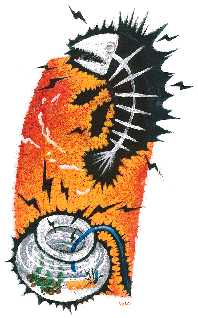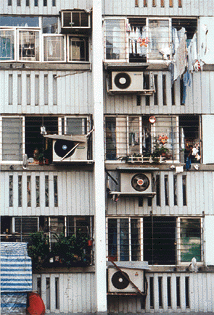Aquarium enthusiasts beware!
Behind the watery tranquillity of an aquarium lurks a hazard that few may be aware. It could be the source of many a domestic fire.
You may be skeptical about this but the chances are unusually high.
According to the Fire Services Department's statistics on domestic fire incidents, about one such fire occurred in every 3 days, on average, in the past 16 months.
The statistics for the period between February 1996 and May 1997 revealed that a total of 158 fire incidents were caused by aquarium appliances - the various electrical devices that keep the aquarium running and its inhabitants well and alive.
This accounted for 2.4% of all (6,547) domestic fires during the same period.
The Consumer Council sounded this fire hazard warning in a test report, published today in the latest (249th) issue of 'CHOICE', on aquarium appliances.
Included in the test were 14 water pumps, 8 submersible water pumps, 6 air pumps and 5aquarium luminaires (fluorescent lamps) at prices ranging from $30 to $500.
The results of the test affirmed the grave fire risk these aquarium accessories pose to their users. Besides fire risk, they can also cause electric shock to the users due to their very close proximity to water.
In fact, the failure rate in the electrical safety of these test samples is so high that aquarium appliances are probably the most unsafe domestic electrical products to be found in a household.
Of the 33 samples, only 5 were considered relatively safe. Among them, 5 submersible water pump models passed all safety tests but 4 lacked the necessary "marking".
The majority of the remainder samples were found to fail poorly in various safety aspects:
Components
27 samples (82%) failed the components test - many had power cord, power plug, fuse, thermostat, capacitor that are not of the type required by the safety standard.
Power Supply Cord
9 samples had power supply cord that is not of the required type meeting the safety standard.
Cord Anchorage
11 samples failed the cord anchorage test - this is to prevent the power cord from being pulled out and pushed into the appliances easily which may loosen the connections and cause fire or electric shock. Some samples were so crude that no cord anchorage was found.
Moisture Resistance
None of the luminaires had the required splash-proof construction. Only 1 water pump and 1 air pump had the required splash-proof construction while all submersible pump samples had watertight construction.
The Consumer Council has passed the findings of the recent tests to the Electrical and Mechanical Services Department. The Department has written to the manufacturers and agents concerned reminding them of the Electrical Products (Safety) Regulation which will come into force in May next year.
In fact, the Electrical and Mechanical Services Department and the Consumer Council have been paying special attention to these products, due to the high rate of reported incidents. EMSD has been involved in some of the investigations of these incidents and the results were also shared with the Consumer Council.
Consumers are advised to consult the test report and stop using all aquarium appliances found to be unsafe. Suppliers are urged to institute voluntary recall of their unsafe products.

Meanwhile, 3 agents have undertaken to the Council that they would improve their products as soon as possible. Consumers should therefore ascertain with the retailer or manufacturer whether the new products they find on the shop shelves have been duly improved to meet the safety standards.
The report also offers a word of caution on installation. It is important to mount the splash-proof appliances (water pump, air pump and luminaire) securely. The aquarium must be so designed that it provides a structure on which to install the aquarium appliances. The structure should prevent the splash-proof appliances from falling into the water inadvertently.
Are you in great urgent need for money?
Even if you are, don't rush to the first bank that offers you a personal loan.
A recent Consumer Council survey has shown that the market for personal loans is becoming more competitive these days that consumers should shop around for loan offers of more favourable interest rates.
The survey, based on 26 banks, deposit-taking companies and money lenders, showed substantial variations of the interest rates (Annualized Percentage Rates) being charged for personal loans: from 9.89% to 59.64%, a difference of nearly 5 times more.
So, it does pay to shop around. For example, for a $200,000 personal loan, to be repaid by 12 monthly instalments, the annual savings from interests between the cheapest and the costliest loan could amount to no less than $44,800. Or in the case of a $100,000 loan, the savings could be $22,400.
The survey found that in most promotional leaflets or materials, interest rates were expressed as a monthly flat rate or reducing balance. These methods of calculation, however, fail to reflect the true lending cost.
There is a common misconception that a monthly flat rate of 1% is equivalent to an annual interest rate of 12%. In fact a 1% flat rate is equal to 23.7% Annualized Percentage Rate (APR) assuming there is no other extra fees.
Consumers should therefore always look for the APR as the method for calculating interest rate and compare the APR among the lenders.
According to the Code of Banking Practice, the APR should take into account all additional charges such as handling fee and insurance fee to reflect the true lending cost to consumers. This practice, however, has not been strictly followed by the companies in the survey.
The survey also noted that lenders impose not only penalty for late payment but also penalty for early redemption.

Residents of public housing estates are urged to ensure their window-type and split-type room air-conditioners are installed securely. Or face the possibility of termination of tenancy.
The Housing Department has recently issued a letter to all public housing resident surging them to abide by the department's Air-Conditioner Installation Regulations. This is of crucial importance as Hong Kong is now in its rainy and typhoon season.
Accidents of unsecured air-conditioners being blown off or falling from high rise buildings present a serious threat to the safety of the passerby below. It is therefore in the interest of all to ensure that their air-conditioners are securely installed.
According to the Housing Department, some 30% of all air-conditioner installations in public housing estates were not in compliance with the safety requirements.
This means that as many as 120,000 air-conditioners have to be re-installed to remove the hazard they pose.
For those who do not comply after 3 warnings, the Housing Department will consider terminating their tenancy agreement.
To assist consumers, the Council has included in this July issue of 'CHOICE' an outline of the department's requirements and a comprehensive guide with illustrated examples and recommendations on how to install air-conditioners safely.
Tenants are reminded to employ registered electrical contractor and his registered electrical worker to carry out the electrical installation.
The rapid growth of the distance-learning market in recent years has raised quite a few consumer concerns.
Notable among the concerns are questions of standard, accreditation and recognition (in both their home countries and Hong Kong) of these overseas courses.
This has prompted the Consumer Council to conduct a study on these areas of concern.
It was reported in 1994 that one overseas university with distance learning outfit was found to lack accreditation or basic recognition in its home country.
But that was before the Non-local Higher and Professional Education (Regulation) Ordinance came into effect on June 20, 1997.
Under the Ordinance, which aims to protect consumers by guarding against the marketing of substandard distance learning programmes conducted in Hong Kong, all programmes leading to the award of non-local academic qualifications or professional qualifications must apply for registration.
Programmes conducted in collaboration with a local institution of higher education will be exempted from registration if it can be certified that the programme meets the standards both in terms of the standing of the institute or professional body and the quality assurance and recognition status of the course.
The Ordinance requires all registered courses to have their registration numbers stated clearly in the advertisements. And in the case of exempted courses, their exemption status should also be stated in the advertisements.
Consumers who plan to enrol in any non-local higher academic or professional courses are strongly advised to :
- choose courses that are registered or exempted;
- check carefully from the advertisements on non-local courses whether there is a registration number or a statement stating that it is an exempted course; and
- inspect the register of registered or exempted courses, as well as important information about these courses kept by the Non-local Courses Registry of the Education Department. The inspection is available to the public free of charge.
Nevertheless, registration under the Ordinance does not on its own confer any particular standing to the course or comparability to a local degree programme.
Whether the qualification is recognised for the purpose of employment in Hong Kong is a matter within the discretion of individual employers.
It was found that a large degree of variations existed among the firms in the acceptance of qualifications obtained through distance learning programmes, for the purpose of employment in Hong Kong.
2 of the 5 organizations surveyed did not accept the distance learning programme qualifications listed in the survey whereas one organization weighed both local qualifications and distance learning programme qualifications equally.
Prospective students should therefore consult the relevant parties regarding the recognition of qualification obtained from distance learning programmes upon application.



